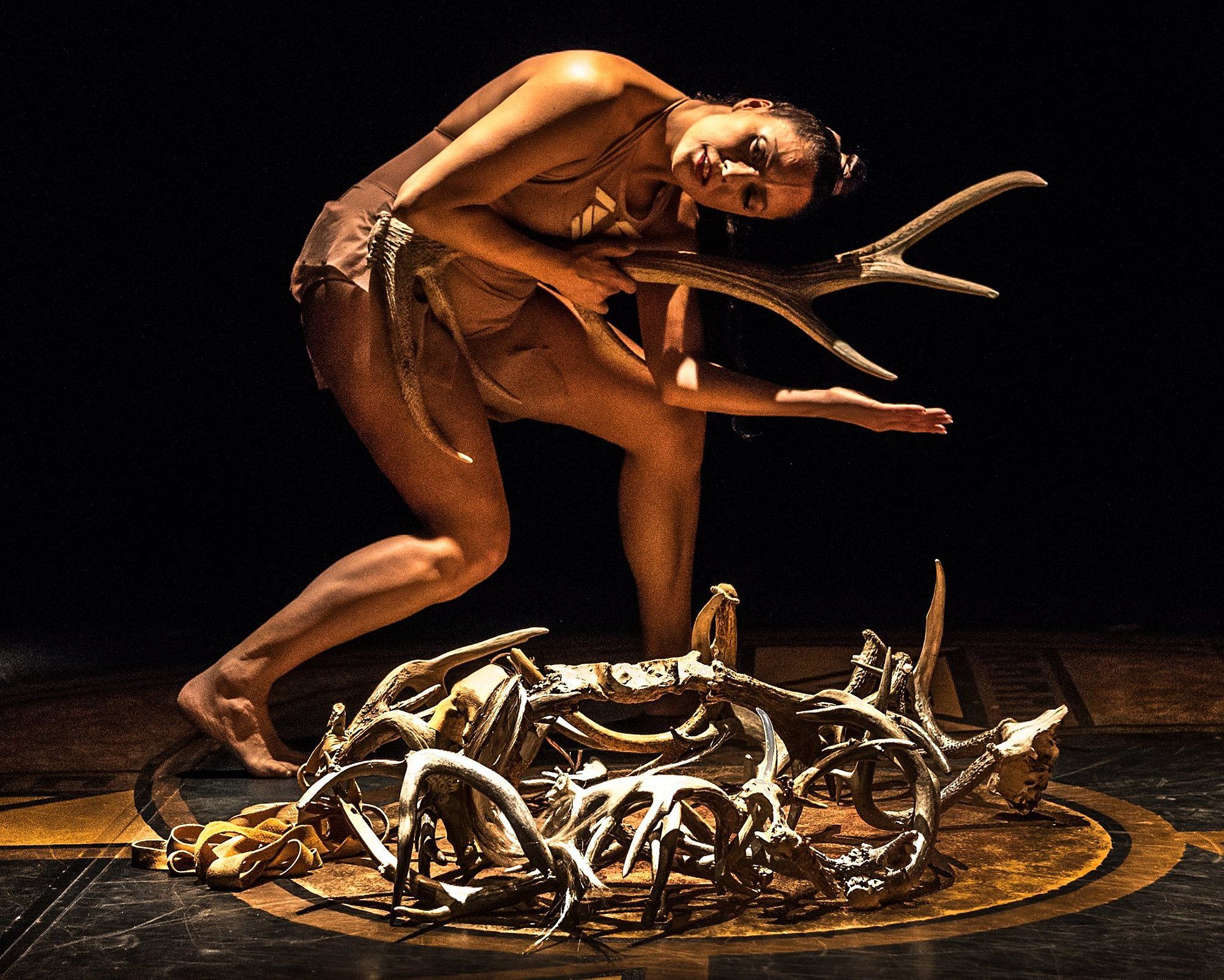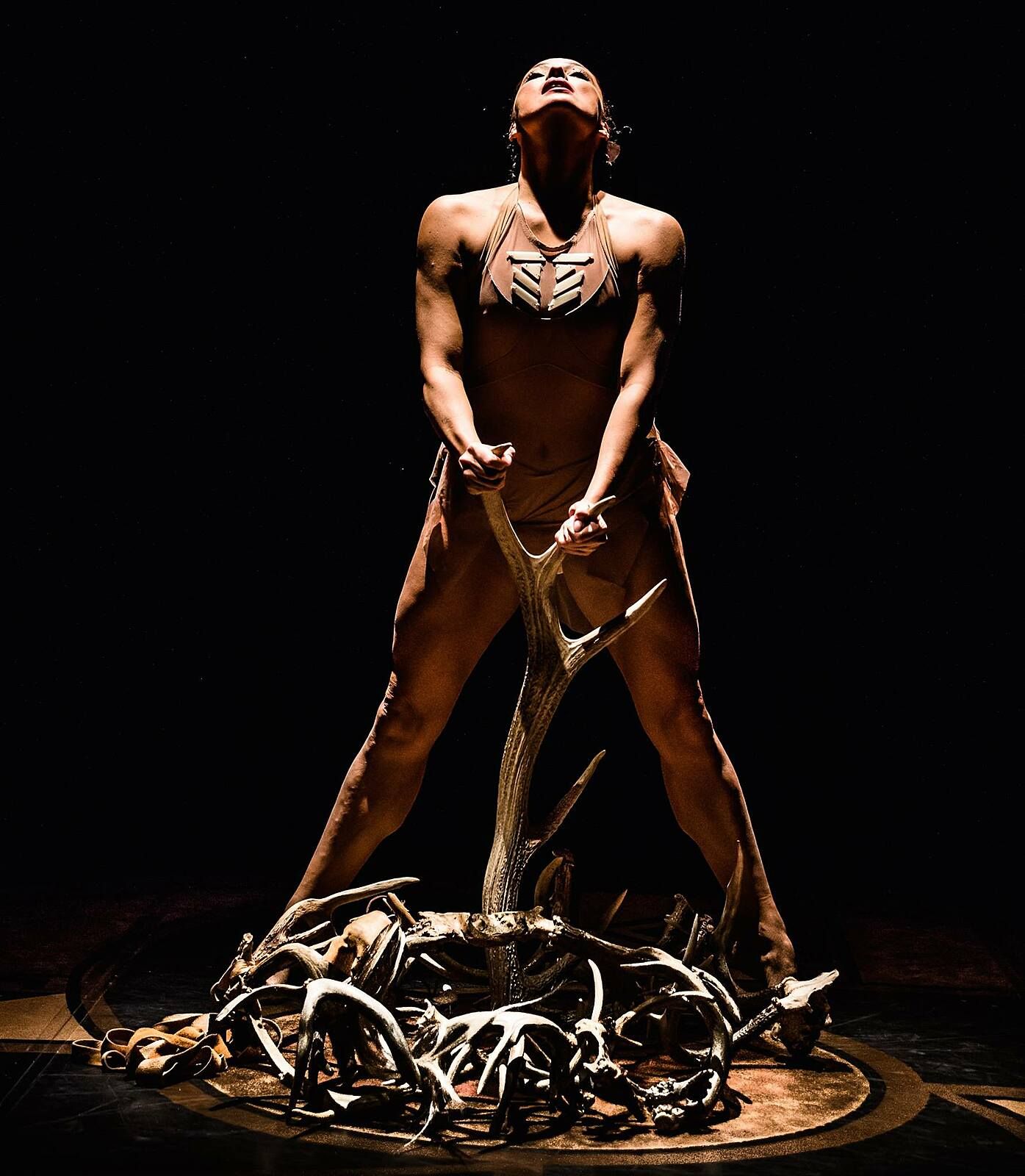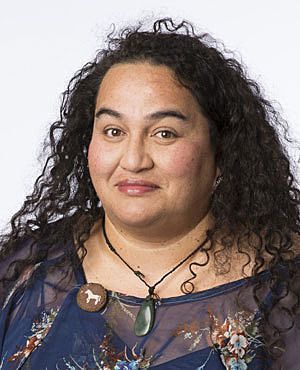Where Is Land In My Body: An Interview with Santee Smith
Santee Smith is the Founding Artistic Director of Kaha:wi Dance Theatre. She discusses her work with Maraea Rakuraku.
Santee Smith is the Founding Artistic Director of Kaha:wi Dance Theatre (pronounced ga-HA-wee and meaning 'to carry' in the Mohawk language). Kaha:wi is a Tkaronto (Toronto) company dedicated to exploring the intersection of Indigenous and new dance performance.
Santee is in Pōneke performing her award-winning solo work NeoIndigenA as part of Tawata Production's Kia Mau Festival. She discusses her influences and the importance of creating Indigenous space such as the Kia Mau Festival with Maraea Rakuraku.
Kia ora Santee, tell me about yourself and your background.
Tekaronhiáhkhwa Santee Smith iónkia'ts, konkwehón:we, Kenien'kehá:ka.
My given name is Santee Smith and my Onkwehon:we name is Tekaronhiáhkhwa (Picking Up The Sky). I’m from the Kenien'kehá:ka (Mohawk) Nation, Turtle Clan from Six Nations of the Grand River territory. I am a mother and artist and thankful for all of creation and the strength of my ancestors. A life-long learner, curious explorer, passionate artist, I’m a lover of our pre-colonial teachings and knowledge. As often experienced by artists, work and life are inseparable both perpetually in a state of becoming. As an artist I hold performance in a sacred space, as all life is sacred. Dance and performance is how I move in the world.
I grew up and still live on Six Nations. I began performing when I was two years old. Whenever I heard music, I would respond viscerally, losing myself to the real world - falling, floating and spinning into a dream realm. I recovered from two broken legs at the age of three. After committing to six years of formal dance training at Canada’s National Ballet School, completing Physical Education and Psychology degrees from McMaster University and theatre training, I returned to dance as a creator/choreographer in 1996.
I enjoy travelling and connecting with other Indigenous Nations around the globe and spending time in natural landscapes and sharing my world with my daughter, Semiah Kaha:wi Smith.
What was your upbringing?
My origins extend from a long ancestral line of Kenien'kehá:ka artists and innovators, individuals who generated their livelihood from their creativity; family who survived as artists and crafts people. I was raised and still reside on Six Nations. It’s my home base.
What are some of your influences?
The majority of my inspiration and perseverance as an artist emanates from my DNA; my family lineage. My paternal grandmother Elda M. Smith is recognised for reviving the lost art of pottery making on Six Nations. My maternal great-grandmother Mary Sky was a Kenien'kehá:ka Clan. She was a mother, midwife, farmer, and traditional cornhusk craftsperson. Her daughter, my todah (grandmother) Rita Vyse continued on with cornhusk, leather and beadwork. These powerful life-sustainers and female ancestors inspire me to continue to express my feminine spirit to uphold the Onkwehon:we matri-focal, matrilineal way of life.
Both of my parents, Leigh and Steve Smith, were native rights activists turned visual artists. They’re pottery makers and spend their lives replicating our ancient iconography, symbols and stories.
Family values include seeking out peace and harmony, beautifying the world and doing the best you can in everything you put your mind, body and spirit to.
What’s your process when it comes to creating and developing work?
Throughout my creative process I maintain a fundamental Onkwehon:we understanding of performance, body and the role of the artist. Music and dance are celebrations of life; the body is a vessel to house our spirit during this earthly existence and the artist’s role is storyteller, mythmaker, and interpreter of symbol and medicine people. From this perspective, my work speaks about identity and humanity in relationship to the universe.
My approach to performance is from an Konkwehon:we Indigenous woman’s lens which is very similar to a Mana Wahine stance.
My approach to performance is from an Konkwehon:we Indigenous woman’s lens which is very similar to a Mana Wahine stance. My process is interdisciplinary, multi-dimensional, intergenerational and intercultural. It spans ancestry to futurity, holding past, present and future in one space, experience, and body. It privileges Indigenous voices and bodies and advocates for works that re-claim, re-construct, re-story and honour our epistemologies.
Is your indigeneity shaped by your art or is your art shaped by your indigeneity?
I feel that my art is shaped by who I am and therefore my indigeneity informs a significant part of my work. I consider myself an artist first and foremost who enjoys expressing through culture, stories, cosmologies and way of life. Our stories, voices, bodies need to be present in our lands honouring past, present and future.
When we are expressing concepts specific to Indigenous what is lost or gained in the transaction from performer to audience?
My work as well as other Indigenous artists’ work is multi-dimensional, including spirituality and ceremony. For example, very specific symbols or imagery might be used that are inspired by Onkwehon:we concepts, so it’s meaningful for myself, but others may have no access or understanding. So part the work can be an educational tool, teaching that there is a vast richness to Indigenous cultures that does not get represented in the mainstream. It shows that our cultures and art are not homogenous, one-dimensional, or adhering to euro-western art paradigms.
Regardless of the understanding, what is easily transmitted is the energy and the live performance experience. I am a firm believer that while witnessing performance, the audiences’ mirror neurons are firing away.
Song, dance and performance are included in most Indigenous gatherings whether they be entertainment, ceremonial or political.
Do you think performance/dance encapsulates the Indigenous experience more, or less, than other mediums?
Song, dance and performance are included in most Indigenous gatherings whether they be entertainment, ceremonial or political. Onkwehon:we people have a performative culture and it is how we celebrate our world and life. Because it requires the whole body, I think performance has a great impact and awareness.
Because the mainstream/majority culture knowledge of Indigenous can be very narrow and stereotypical, how do you manage that? How does it inform your work?
I don't adhere to following stereotypes, in fact most audiences who come and see my work are surprised that it’s not what they expected to see. In North America the dominant culture likes to view Indigenous peoples as Plains, Hollywood Indian types, and pan-powwow as the main style of dance. This is quite far from reality, considering all of the Nations. Also considering the fact artistic individuals are not interested in replicating imposed notions of identity which support a settler’s gaze.
My content deals with topics that are not well known in dominant culture. For example, our recent touring production The Honouring tells the Onkwehon:we experience and involvement in the war of 1812. The presence and contributions to the lands that my people and other Nations have made go virtually unnoticed. It’s not taught in the education system so we have a whole country that does not know its true history. This also helps perpetuate stereotypes and negative images of Indigenous people.
As Indigenous worldwide resist fracking, and wage action against corporates, including the Standing Rock Occupation, do these more current events inform your work? How?
Water is Life. Through my artistic work and life, I try to uphold our original teachings which include being a custodian for the natural world, recognizing our interconnected kinship relationship to the universe, and to honour our Mother the Earth. Onkwehon:wen have an karakia that addresses and gives greetings and gratitude to all the elements of nature, placing human beings in this web of life, not as masters but as caretakers.
The process of welcoming to the whenua, acknowledging our ancestors and ancestral lands, and expanding our whānau makes a festival like Kia Mau so powerful in affirming our inter-connectivity and Indigenous experience.
Is there a commonality of experience? Or put another way, is there an ease due to a shared indigenous experience, when it's Indigenous hosting a festival like Kia Mau?
The main commonality would be the kaupapa of creating Indigenous space to exchange, develop and present our work in our own ways. The process of welcoming to the whenua, acknowledging our ancestors and ancestral lands, and expanding our whānau makes a festival like Kia Mau so powerful in affirming our inter-connectivity and Indigenous experience.
What was your knowledge of Māori prior to your visit in 2016?
I have been collaborating with many Māori artists and scholars, and have read the works of people like Linda Tuhiwai Smith on decolonising methodologies. Back in 1998-2001, I worked alongside several Māori dancers at the Banff Centre for the Arts on a production called, Bones: An Aboriginal Dance Opera. We had the opportunity to engage in cultural exchange, sharing waiata and our dances. So my sharing and learning has been ongoing and each time I am able to kōrero and share mahi, the deeper the knowledge. I have also invited and hosted Māori artists in my community and this summer I’ll be bringing others over such as Taane Mete and the cast and creatives of Hawaiki TŪ to work in Tkaronto (Toronto) and Six Nations.
What are some similarities or differences you've encountered in contact with Māori and Māori arts practitioners, and other Indigenous nations?
First Nations across Turtle Island share many similarities and also differences with Aotearoa. We certainly share similar effects of colonisation, cultural assimilation and appropriation and the atrocious statistical rates. What we also share is mana, resilience, activism, connection to our cosmology, respect for Ranginui and Papatūānuku and the natural universe. We retain our inherent rights to our lands, treaties and kinship relationships.
At home, Onkwehon:we have a very similar welcome to pōwhiri called Karak:tah (The Edge of the Woods).
How did you experience the pōwhiri? Are there similarities with the initial encounters your nations have when you meet others for the first time?
I have experienced a few pōwhiri in Aotearoa, both on marae and off. At home, Onkwehon:we have a very similar welcome called Karak:tah (The Edge of the Woods). The Edge of the Woods is a welcoming process and includes oration (formal speeches), welcome songs, sharing of kai and gifts, purification, and relieving visitors of their burdens, in order for them to enter the community with good and peaceful intentions. It is connected to our treaty relationships of the Two Row Wampum.
Why is it important to you, that your work is experienced here?
I am super excited to be performing in Aotearoa. This will actually mark my premiere performance in the whenua. NeoIndigenA is a great work to share since it is such a personal journey and I’m interested to see how it resonates with audiences here. Being at the Kia Mau Festival sharing knowledge and performance is important; it’s being at the forefront of creating global Indigenous artistic platforms of our work.
What do you want audiences to experience with NeoIndigenA?
I would suggest that audiences try not to understand with an analytical mind, but to be open to the experience of the performance. Since I aim to create a ceremonial space, there are aspects that are indescribable, that hit only the unconscious level. There is no literal narrative - audiences will need to draw their own understanding and contemplate their response and thoughts and feelings the performance may evoke. I encourage audiences to be active receivers.
NeoIndigenA is intense, transportive, organic, elemental and all-encompassing for audiences. In this journey, I abandon myself to be unleashed and more vital, experiencing many deaths and rebirths to ask: where is land in my body? What do my bones speak? What is flesh, blood and breath connection to earth and to sky? I acknowledge my ancestors and give thanks for this body on my earth walk and call out to my ancestors, “make my path”. Audiences will be asked to acknowledge their own ancestors throughout the performance from the beginning with a request to write on a fabric tie, “what do you want to say or tell an ancestor?” At the end they tie their tie to the NeoIndigenA portal.
Where is land in my body? What do my bones speak?
What do you think of the kai here? Have you seen much of Aotearoa? Will you this time?
I really enjoy eating the fush…!
I have been to Aotearoa six times now, every time for work, research and collaboration with Māori artists. The very first time I travelled here in 2006 was to the Pōneke region on an international Indigenous exchange with Ojibway spoken word/writer Kateri Akiwenzie-Damm and composer Dean Hapeta on a work called A Constellations of Bones. I came back in 2010 to attend Kōwhiti Dance Festival, where I met the Māori contemporary dance community and collaborators Charles Koroneho, Louise Potiki Bryant, Jack Gray and others. I returned in 2015 to collaborate on my work Re-Quickening with videographer/choreographer Louise Potiki-Bryant and dance artists Nancy Wijohn and Bianca Hyslop. In December 2016, I was in collaboration on my newest work Blood Tides with dance artists Kura Te Waati, Sophie Williams, Nancy Wijohn and cultural advisor Ngahuia Sharney Murphy, working in Auckland, Piha and Whakatane.
So far I have experienced the whenua in Auckland, Piha, Paihia, Rotorua, Taupo, Whakatāne, Tauranga, Mount Maunganui, travelled throughout the Coromandel and into Hokianga areas.
I attended Kia Mau Festival 2016 and I’m thrilled to keep growing kinship with Māori artists and producers. I align with the kaupapa of producers like Hone Kouka and Mīria George at Tawata Productions, investing in the creation of Indigenous platforms on our own terms. These connections are vital to shape and build our work globally together, to learn from each other and to uplift our culture and spirits.
NeoIndigenA runs from 6-10 June at BATS Theatre. Tickets available here.
Find out more about Kia Mau Festival here.


